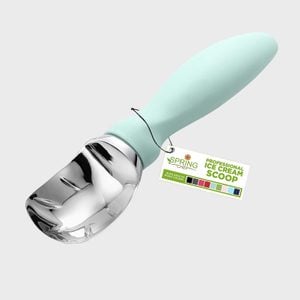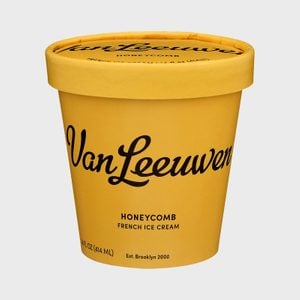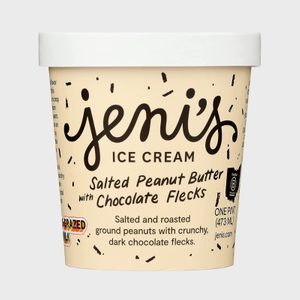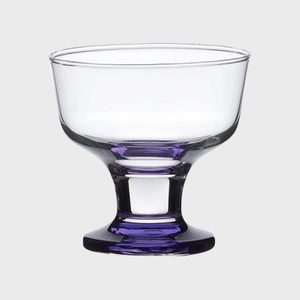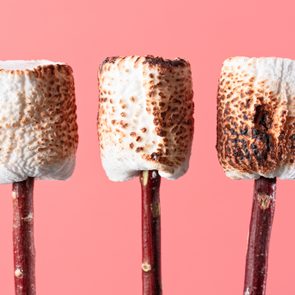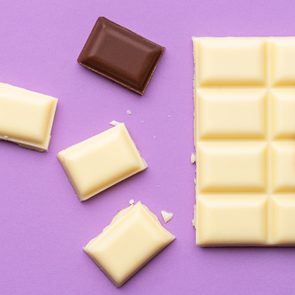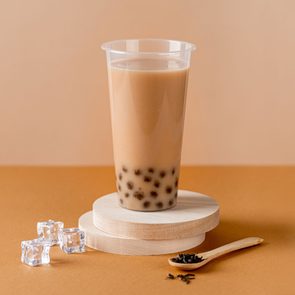The History of Ice Cream, One of the World’s Oldest Desserts
Updated: Jul. 25, 2024
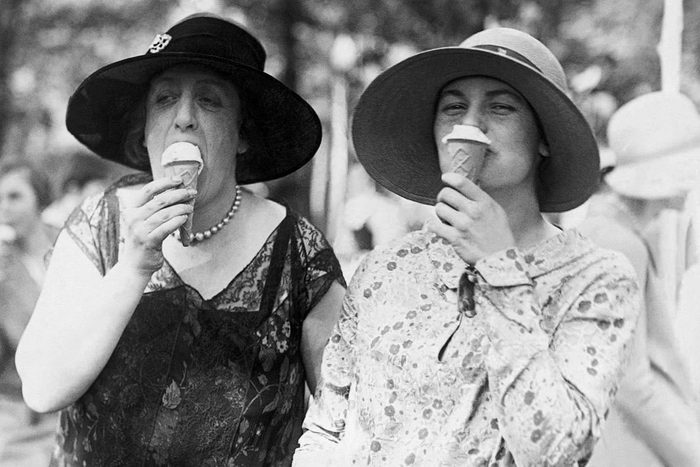
When a food has been around this long, it can be hard to separate fact from folklore. We tapped food historians to find out who really invented ice cream.
America is in a serious, long-term relationship with ice cream. It’s the food we use when celebrating birthdays, Little League wins, and other special occasions. We have the person who invented ice cream to thank for the two scoops that give us a bit of comfort after a rough day and the pint (or two) that get us through a nasty breakup. Regardless of the situation, ice cream is there for us. So it’s no wonder that poll after poll finds that ice cream is one of America’s favorite desserts.
Need more evidence of the country’s love affair with ice cream? According to the U.S. Census Bureau, Americans consume an average of 23 gallons of ice cream each year. Classic vanilla is the most popular flavor in America, accounting for more than 26 percent of the country’s ice cream sales. However, a study released in July 2021 (just in time for National Ice Cream Day on July 18) found that we are, as a nation, branching out to other favorite flavors, including moose tracks, rocky road, coffee, birthday cake, and green tea.
If you enjoy food facts and trivia, you’re probably curious about classic showdowns such as gelato vs. ice cream and sorbet vs. sherbet, the story behind why we don’t see grape ice cream, and ice cream traditions around the world. And there’s a good chance you’ve tried to figure out who invented ice cream.
Those who’ve spent time researching ice cream history know that there are a lot of competing stories out there with conflicting information and little to no evidence to back up the claims. But if your quest for ice cream knowledge has left you with a brain freeze, you’ve come to the right place. With the help of food historian Sarah Wassberg Johnson and others who’ve put in the time digging through newspaper archives and primary documents, we’ve answered some of your most pressing ice cream-related questions.
How did ancient people harvest ice?
To have ice cream, you need to have a way to keep it cold. And in the days before refrigeration, that meant you needed ice if you wanted chilled food. “It’s tough to pinpoint the origin of ice cream or even the ancestors of ice cream, but the general consensus is that in the ancient world, people got ice a couple of different ways,” Wassberg Johnson says.
Some harvested ice that formed on natural sources, but that wasn’t always as easy as stepping outside into a wintry wonderland. “In the ancient world, lakes didn’t really freeze in the Mediterranean and Middle East, so they were getting glacial ice and snow from high up in the mountains,” she says. All the time and effort that went into collecting ice made it something that only the wealthiest people could afford.
Getting ice in the desert—in places like Ancient Egypt—was another story. According to Wassberg Johnson, there’s evidence that people would use evaporation for cooling purposes. “When you put water in a porous clay container and wrap it with a wet cloth, evaporation would pull the heat out of whatever was in there,” she explains. “Or, in desert areas where it would freeze at night, they would put out very shallow dishes filled with water and get a thin piece of ice that way.”
Which country invented ice cream?
As with many aspects of food history, there’s no way to definitively know who invented ice cream, or which country it originated from. The first references to ice houses and actually eating snow come from 11th century BCE China. “Then, around 200 BCE, there’s a reference to people in China eating [a combination of ] milk and rice that was frozen in the snow,” she says.
How did we go from that to something that more closely resembles our modern types of ice cream? We have the Persians to thank. Around 400 BCE, they invented the predecessor to artificial refrigeration: a large pyramidal structure called a yakhchal that used evaporation and insulation to keep things cool.
By the 11th century CE, Persians were making something called sharbat, which Wassberg Johnson says is “probably the closest ancestor, at least linguistically, to ice cream, and where the word ‘sherbet’ comes from.” Thanks to trading with the Indian Empire, Persians had access to sugar, which they combined with water and flavorings to create sharbat.
The icy treat “came to Europe through Moorish influence after the Crusades,” she explains.
When was modern ice cream invented?
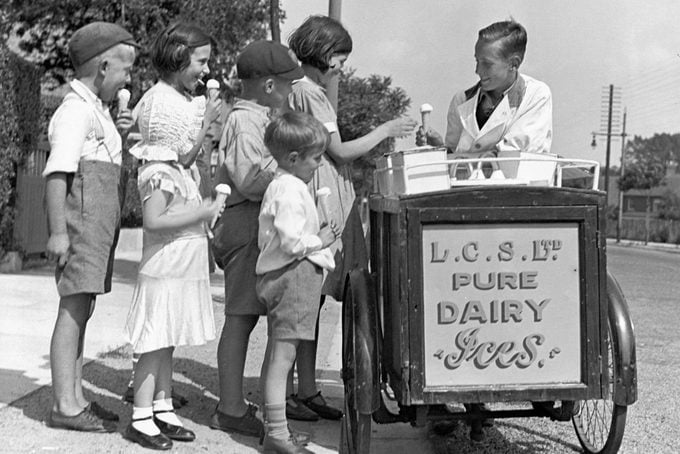
It wasn’t until the Age of Exploration, when White Europeans colonized the Americas, that modern ice cream made its debut. “The Spanish Empire was the first European group to colonize the ‘New World,’ and they got involved with sugar production and bringing chocolate and vanilla from Mexico and the Yucatán Peninsula in the 16th century,” Wassberg Johnson explains. “Naples, Italy, was also part of the Spanish Empire at the time, and sorbetto, or sorbet, originates there.”
French aristocrats started eating the frozen dessert next, followed by those in England—”the land of all things dairy,” as Wassberg Johnson puts it—who froze combinations of milk and cream.
By the 18th century, ice cream was all the rage in Europe. Using locally produced milk and cream, ice harvested from lakes, and the sugar and molasses that came through the Atlantic slave trade—as well as the labor of enslaved people—wealthy American colonists had access to ice cream, Wassberg Johnson says. People like George Washington and Thomas Jefferson had ice cream–making pots imported from Europe.
In fact, Jefferson’s love of ice cream, which was especially evident when he served it at the President’s House (now called the White House) in Washington, D.C., is part of what helped popularize the dessert in the United States. But of course, Jefferson didn’t make the ice cream himself; that was left up to his staff, including his French-trained (but still enslaved) chef James Hemings, his French butler Adrien Petit, and Honoré Julien, a French chef who cooked for Jefferson throughout his presidency.
Who is the father of ice cream?
Another presidential chef—a free Black man from Philadelphia named Augustus Jackson—is referred to as the “father of ice cream.” Though he isn’t the person who invented ice cream, he’s credited with inventing the modern method of manufacturing ice cream (adding salt to the ice to lower and control the temperature).
But as Maria Panaritis pointed out in a 2019 article for the Philadelphia Inquirer, there are very few mentions of Jackson in any historical records, including newspaper archives. Though there are multiple present-day articles on Jackson’s life, they provide conflicting information about what he did and when. From what does exist, it appears he worked as a cook in the White House sometime between 1817 and 1837, then returned to Philadelphia, where he opened his own confectionery and/or catering business that manufactured and distributed ice cream around the city.
Coincidentally, America’s oldest ice cream brand is also based in Philadelphia. Bassetts Ice Cream has been in operation since 1861, opened its first shop in 1885, and moved into the city’s iconic Reading Terminal Market when it opened in 1892. It’s been serving up scoops in that location ever since.
Just over a decade later, ice cream’s BFF, the waffle-like cone, was invented, and by accident!
Does ice cream have eggs in it?
Eggs are an ingredient in some (but not all) ice creams. This is where things can get a little tricky. In the mid-1700s, French chefs put their own spin on the dessert, which was gaining popularity throughout Europe at the time. In addition to the regular ingredients found in ice cream—milk, cream, sugar, and flavoring (usually vanilla)—they also included egg yolks in their recipe, making what we now consider frozen custard.
Fast-forward to present-day United States. The Food and Drug Administration (FDA) regulates which products can be considered ice cream and which are, by definition, frozen custard. It comes down to egg yolks: Ice cream contains at least 10 percent milkfat and less than 1.4 percent egg yolk, while custard also contains at least 10 percent milkfat but must have more than 1.4 percent egg yolk. (Interestingly, those regulations are part of the reason British and American vanilla ice creams taste so different.)
Where did some of the most popular ice cream flavors come from?
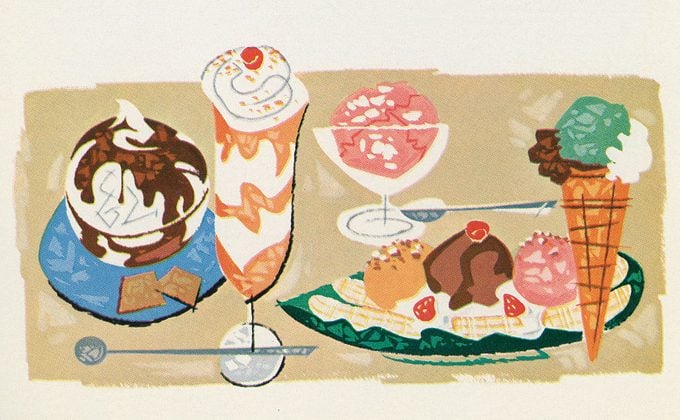
Part of the appeal of ice cream is that it comes in such a wide variety of flavors, with new ones being invented all the time. But it wasn’t always this way. Although there is no way to definitively know what the first flavor of ice cream ever invented and eaten by humans was, Wassberg Johnson says that one of the earliest mentions of eating ice and dairy food with some type of flavoring is from China during the Tang dynasty (618–907 CE). “It was a mixture of flour, water buffalo milk, and camphor that was frozen,” she explains, noting that it wasn’t enriched with eggs (like a custard) and didn’t contain added sugar.
You probably won’t find camphor-flavored scoops at your local ice cream shop, but other early flavors are still popular today—including what historians believe is the first flavor of modern ice cream.
Chocolate
As far as modern ice cream flavors go, chocolate was likely invented first, according to Sarah Lohman, a food historian and author of Eight Flavors: The Untold Story of American Cuisine. “Because of the precedent of frozen drinks, some of the earliest ice cream flavors were drinks, like coffee and tea,” she writes. “[This] is why chocolate ice cream was invented long before vanilla.”
The first frozen chocolate recipe came from Naples, Italy, published in Antonio Latini’s 1692 book The Modern Steward, Lohman notes.
Vanilla
Though he didn’t invent ice cream—or even introduce it to America— Jefferson is credited with the first-known ice cream recipe recorded by an American. The flavor? Vanilla.
But it was Jefferson’s enslaved chef, James Hemings, who is thought to have perfected vanilla ice cream. “Hemings trained as a French chef while in France with Jefferson,” says Wassberg Johnson. “When they returned, they brought back vanilla ice cream, macaroni and cheese, and whipped cream. Hemings became the person in Jefferson’s household who helped popularize a lot of those foods in the United States.”
Fast forward more than two centuries, and the flavor still reigns in America. It’s wedged between chocolate wafers in ice cream sandwiches, added atop apple pie, blended into milkshakes, and eaten straight from the carton after tough days at work.
Butter pecan
It’s unclear who invented butter pecan, but according to an oft-repeated piece of Jim Crow-era folklore, the classic flavor became popular among Black Americans when they were not permitted to eat vanilla ice cream. That said, no evidence has been found to verify the story, according to Kelly Nusz and Darryl Goodner, who started “Butter Pecan Podcast” to get to the bottom of this mystery of food history.
Strawberry
There is no solid evidence identifying the person who invented strawberry ice cream either. “There’s an apocryphal story that can’t be proven one way or the other about a formerly enslaved woman named Aunt Sallie Shadd who supposedly invented strawberry ice cream for Dolley Madison,” Wassberg Johnson explains. “Though Sallie was a real person, whether or not she was the first person to invent strawberry ice cream is debatable. She was involved in the ice cream trade in the 1810s and 1820s.”
How did ice cream become so popular?

While the ice cream trade started off small and highly localized, it took off once artificial refrigeration became available—first commercially, then in people’s homes—and ice cream was suddenly more accessible to people of different socioeconomic classes. These days, you can find thousands of ice cream shops across the nation, packaged ice cream in supermarkets and corner stores, and ice cream trucks selling the chilled dessert to eager children. And you can pick from a profusion of flavors, including classics like vanilla and chocolate; modern favorites like milk and cookies, caramel macchiato, and chai tea; and truly weird ice cream flavors like cheddar cheese, cereal milk, lobster, and everything bagel.
Its ubiquity hasn’t diminished its allure. “Like a lot of foods, ice cream has held onto its earlier connotation with the wealthy,” says Wassberg Johnson. “Even though it’s available all the time now, it still has this association with special occasions.” So the next time you dish up some ice cream to serve alongside a birthday cake, you’ll know why.
Sources:
- Sarah Wassberg Johnson, food historian
- Sarah Lohman, food historian and author of Eight Flavors: The Untold Story of American Cuisine
- U.S. Census Bureau: “National Ice Cream Month and Day: July and July 18, 2021”
- Instacart: “Instacart Scoops Up America’s ‘Flavorite’ Ice Cream in Every State”
- Food and Drug Administration: “CFR – Code of Federal Regulations Title 21”
- The Philadelphia Inquirer: “The ‘father of ice cream’ was a black Philadelphian who served in the White House. Or was he?”
- Butter Pecan Podcast: “E5. Butter Pecan Ice Cream”




















